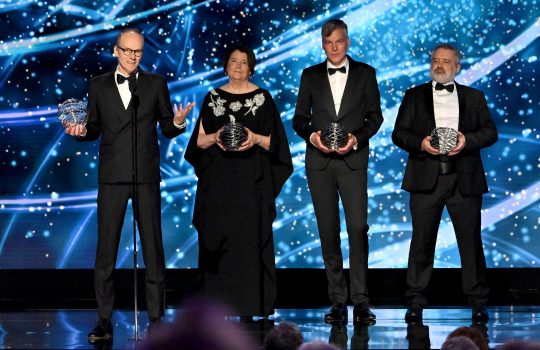Batavia, IL and Upton, NY – The Large Hadron Collider has launched a new era for particle physics. Today at 6:06 a.m. CDT (1:06 p.m. Central European Summer Time) at CERN in Geneva, Switzerland, the first particles collided at the record energy of seven trillion electron volts (TeV). These collisions mark the start of a decades-long LHC research program, and the beginning of the search for discoveries by thousands of scientists around the world.
“Today’s first 7 TeV collisions are a great start for LHC science,” said Dr. Dennis Kovar, Associate Director of Science for High Energy Physics at the U.S. Department of Energy. “We eagerly anticipate the work of the world’s physicists as they begin their search for dark matter, extra dimensions, and the ever-elusive Higgs boson.”
Today’s proton collisions were recorded by the LHC experiments’ particle detectors, known by their acronyms: ATLAS, CMS, ALICE and LHCb. While the LHC accelerator brings the protons up to their maximum energy and steers them around the 16-mile ring into collision, the experiments use massive particle detectors to record and analyze the collision debris.
“The LHC experiments are the world’s largest and most complex scientific instruments, and scientists from American universities and laboratories have made vital contributions to each of them,” said Dr. Edward Seidel, Acting Assistant Director of the National Science Foundation’s Directorate For Mathematical and Physical Sciences. “We wish all the LHC scientists success in their quest to solve some of the most profound mysteries of our universe.”
More than 1,700 scientists, engineers, students and technicians from 89 American universities, seven U.S. Department of Energy (DOE) national laboratories, and one supercomputing center helped design, build and operate the LHC accelerator and its four massive particle detectors. American participation is supported by the DOE’s Office of Science and the National Science Foundation (NSF).
Now, the real work begins for the LHC teams. Over the next 18 to 24 months, the LHC accelerator will deliver enough collisions at 7 TeV to enable significant advances in a number of research areas. As data begins to pour from their detectors, more than 8,000 LHC scientists around the world will sift through the flood in search of the tiny signals that could indicate discovery.
“It’s a great day to be a particle physicist,” said CERN Director General Rolf Heuer. “A lot of people have waited a long time for this moment, but their patience and dedication is starting to pay dividends.”
The DOE’s Brookhaven National Laboratory and Fermi National Accelerator Laboratory are the host laboratories for the U.S. groups participating in the ATLAS and CMS experiments, respectively. Scientists from American universities and laboratories, who comprise more than 20 percent of the ATLAS collaboration and 35 percent of CMS, have played major roles in the construction of both detectors, and join thousands of international colleagues as they operate the detector and analyze the collision data that will be collected in the coming years. In addition, Lawrence Berkeley National Laboratory is the host laboratory for U.S. groups participating in ALICE, with American scientists contributing 10 percent of the ALICE collaboration.
The United States is also home to major national and regional computing centers that, as part of the Worldwide LHC Computing Grid, enable scientists in the United States and around the world to access the enormous amount of data generated by the LHC experiments. Brookhaven National Laboratory and Fermi National Accelerator Laboratory, host to major “Tier-1” computing centers, are the first stop in the U.S. for data from the ATLAS and CMS experiments, respectively. The data are further distributed to smaller NSF and DOE-funded “Tier-2” and “Tier-3” computing centers across the country, where physicists will conduct the analyses that may lead to LHC discoveries.
Notes for editors:
Photos and video from today’s events are available at:
http://press.web.cern.ch/press/lhc-first-physics/
For more information about American participation in the Large Hadron Collider, visit http://www.uslhc.us.
Brookhaven National Laboratory is operated and managed for the Department of Energy’s Office of Science by Brookhaven Science Associates and Battelle. Visit Brookhaven Lab’s electronic newsroom for links, news archives, graphics, and more: http://www.bnl.gov/newsroom.
Fermilab is a U.S. Department of Energy Office of Science national laboratory, operated under contract by the Fermi Research Alliance, LLC. The U.S. Department of Energy Office of Science is the nation’s single-largest supporter of basic research in the physical sciences. Visit Fermilab’s website at http://www.fnal.gov.
CERN, the European Organization for Nuclear Research, is the world’s leading laboratory for particle physics. It has its headquarters in Geneva. At present, its Member States are Austria, Belgium, Bulgaria, the Czech Republic, Denmark, Finland, France, Germany, Greece, Hungary, Italy, Netherlands, Norway, Poland, Portugal, Slovakia, Spain, Sweden, Switzerland and the United Kingdom. India, Israel, Japan, the Russian Federation, the United States of America, Turkey, the European Commission and UNESCO have Observer status.
Full list of U.S. institutions participating in the Large Hadron Collider project
Arizona
University of Arizona
California
California Institute of Technology
California Polytechnic State University
California State University, Fresno
Lawrence Berkeley National Laboratory
Lawrence Livermore National Laboratory
SLAC National Accelerator Laboratory
University of California, Davis
University of California, Irvine
University of California, Los Angeles
University of California, Riverside
University of California, San Diego
University of California, Santa Barbara
University of California, Santa Cruz
Colorado
University of Colorado
Connecticut
Fairfield University
Yale University
Florida
Florida Institute of Technology
Florida International University
Florida State University
University of Florida
Illinois
Argonne National Laboratory
Fermi National Accelerator Laboratory
Northern Illinois University
Northwestern University
University of Chicago
University of Illinois at Chicago
University of Illinois, Urbana-Champaign
Indiana
Indiana University
Purdue University
Purdue University Calumet
University of Notre Dame
Iowa
Iowa State University
University of Iowa
Kansas
Kansas State University
University of Kansas
Kentucky
University of Louisville
Louisiana
Louisiana Tech University
Maryland
Johns Hopkins University
University of Maryland (40)
Massachusetts
Boston University
Brandeis University
Harvard University
Massachusetts Institute of Technology
Northeastern University
Tufts University
University of Massachusetts, Amherst
Michigan
Michigan State University
University of Michigan
Wayne State University
Minnesota
University of Minnesota
Mississippi
University of Mississippi
Nebraska
Creighton University
University of Nebraska-Lincoln
New Jersey
Princeton University
Rutgers University
New Mexico
University of New Mexico
New York
Brookhaven National Laboratory
Columbia University
Cornell University
New York University
Rockefeller University
State University of New York at Albany
State University of New York at Buffalo
State University of New York at Stony Brook
Syracuse University
University of Rochester
North Carolina
Duke University
Ohio
Case Western Reserve University
Ohio State University
Ohio Supercomputer Center
Oklahoma
Langston University
Oklahoma State University
University of Oklahoma
Oregon
University of Oregon
Pennsylvania
Carnegie Mellon University
University of Pennsylvania
University of Pittsburgh
Puerto Rico
University of Puerto Rico
Rhode Island
Brown University
South Carolina
University of South Carolina
Tennessee
Oak Ridge National Laboratory
University of Tennessee
Vanderbilt University
Texas
Rice University
Southern Methodist University
Texas A&M University
Texas Tech University
University of Houston
University of Texas, Arlington
University of Texas, Austin
University of Texas, Dallas
Virginia
Hampton University
University of Virginia
Washington
University of Washington
Wisconsin
University of Wisconsin-Madison



